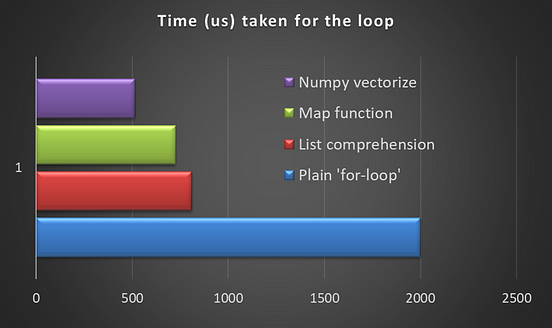

So let us understand the the numpy.vectorize () function in more detail: numpy.vectorize (pyfunc, otypesNone, docNone, excludedNone, cacheFalse, signatureNone) Required Parameters: pyfunc: The function. Print("Finding maximum element takes %0.9f units using for loop"%time_forloop) Numpy Vectorization essentially functions like the python map () but with additional functionality the NumPy broadcasting mechanism. from itertools import combinations import numpy as np n 100 np.ed (2) A np.random.rand (n,n) globalbest 1000000000000000.0 for i, j, k in combinations (range (n), 3): localbest np.amax (np. Time_numpy = Timer(max_using_numpy).timeit(1) You can use combinations from itertools, that it's a python standard library, and it will help you to to remove all those nested loops. Time_builtin = Timer(max_using_built-in_method).timeit(1)
#Numpy vectorize free
Time_forloop = Timer(max_using_forloop).timeit(1) Q & A on everything about programming languages Devebee mainly focuses on providing free and high quality tutorials and practical guides that related to IT based problems.

Print("Summing elements takes %0.9f units using numpy"%time_numpy) Print("Summing elements takes %0.9f units using builtin method"%time_builtin) Print("Summing elements takes %0.9f units using for loop"%time_forloop) Execute func1d (a, args, kwargs) where func1d operates on 1-D arrays and a is a 1-D slice of arr along axis. Time_numpy = Timer(sum_using_numpy).timeit(1) Apply a function to 1-D slices along the given axis. This means our output shape (before taking the mean of each inner 10x10 array) would be: >.

We have a 2d array img with shape (254, 319) and a (10, 10) 2d patch.

#Numpy vectorize Patch
Time_builtin = Timer(sum_using_builtin_method).timeit(1) An instructive first step is to visualize, given the patch size and image shape, what a higher-dimensional array of patches would look like. Time_forloop = Timer(sum_using_forloop).timeit(1) NumPy being a C implementation of arrays in Python provides vectorized actions on NumPy arrays.Īrray = np.random.randint(1000, size=10**5) The main reason for this slow computation comes down to the dynamic nature of Python and the lack of compiler level optimizations which incur memory overheads. Python is an interpreted language and most of the implementation is slow. Python for-loops are slower than their C/C++ counterpart. Vectorized array operations will be faster than their pure Python equivalents, with the biggest impact in any kind of numerical computations. Instead, we use functions defined by various modules which are highly optimized that reduces the running and execution time of code. Vectorization is a technique of implementing array operations without using for loops. In this tutorial, we will learn about vectorizing operations on arrays in NumPy that speed up the execution of Python programs by comparing their execution time. This is where vectorization comes into play. Processing such a large amount of data in python can be slow as compared to other languages like C/C++. Offsets for a 3×3 window are given below. Neighbor values are easily identified with row and column offsets. Many complex systems nowadays deal with a large amount of data. To implement a moving window, simply loop over all of the interior array elements, identify the values for all neighbor elements, and use those values in your specific calculation. direct array calculation with reshape and broadcast to avoid loop in pure python (both vectorize and amap are the later case).In this article, we’ll be learning about Vectorization. If the performance is really important, you should consider something else, e.g. I didn’t check it, Any performance test are welcome. The vectorized function evaluates pyfunc over successive tuples of the input arrays like the python map function, except it uses the broadcasting rules of numpy. Thus we would expect the amap here have similar performance as vectorize. Define a vectorized function which takes a nested sequence of objects or numpy arrays as inputs and returns a numpy array as output. The implementation is essentially a for loop. The vectorize function is provided primarily for convenience, not for You may also wrap it with lambda or partial for convenience g = lambda x:amap(f, x) Let try def f( x): return x * np.array(, dtype=np.float32) def amap( func, *args): '''array version of build-in mapĪmap(function, sequence) -> array I’ve written a function, it seems fits to your need.


 0 kommentar(er)
0 kommentar(er)
